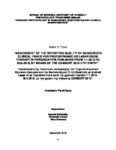Critical review of lasers in benign prostatic hyperplasia (BPH)
Fecha
2011Materia
Resumen
Laser technology has been applied to treat LUTS secondary to BPH for > 15 years. Some of the early approaches failed to fulfil our expectations and have been abandoned, but technological advancements and growing clinical experience have produced more refined techniques and devices with clinical outcomes that seem to challenge transurethral resection of the prostate. Using an evidence-based approach, this review explains the basic principles of lasers and updates our knowledge on the progress of laser technology and the role of different laser techniques and types in the treatment of LUTS due to BPH in both the general population and specific groups of patients. The study also documents the need for better quality data to increase the level of evidence for each laser treatment. Laser treatment of benign prostatic hyperplasia has challenged transurethral resection of the prostate (TURP) due to advances in laser technology, better understanding of tissue-laser interactions and growing clinical experience. Various lasers have been introduced including neodymium: yttrium aluminium garnet (YAG), holmium (Ho) : YAG, potassium titanyl phosphate : YAG, thulium(Tm) and diode laser. Based on the different wave-length dependent laser-prostatic tissue interactions, the main techniques are coagulation, vaporization, resection and enucleation. The present review aims to help urologists to distinguish and to critically evaluate the role of different laser methods in the treatment by using an evidence-based approach. It also details further evidence for use in specific patient groups (in retention, on anticoagulation) and addresses the issues of cost and learning curve. Coagulation-based techniques have been abandoned; holmium ablation/resection of the prostate has been superseded by the enucleation technique Ho-laser enucleation of the prostate (HoLEP). The short-term efficacy of the emerging laser treatments such as diode and Tm prostatectomy has been suggested by low quality studies. HoLEP and photoselective vaporization of the prostate (PVP) represent valid clinical alternatives to TURP. HoLEP is the most rigorously analysed laser technique with durable efficacy for any prostate size and low early and late morbidity. PVP has grown in acceptance and popularity but long-term results from high quality studies are pending.
Colecciones
Ítems relacionados
Mostrando ítems relacionados por Título, autor o materia.
-
Coupled thermodynamic/kinetic analysis of diffusional transformations during laser hardening and laser welding
Haidemenopoulos, G. N. (2001)Several important industrial material processes, such as welding and surface treatments with high energy beams, incorporate rapid thermal cycles characterized by high heating/cooling rates and short dwell times. Computational ...

